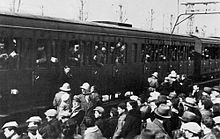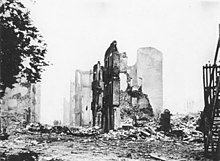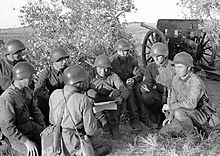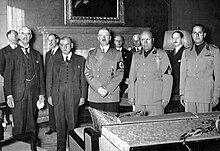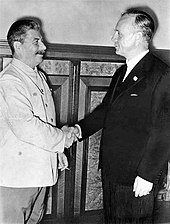Italian invasion of Ethiopia (1935)
The Second Italo–Abyssinian War was a brief colonial war that began in October 1935 and ended in May 1936. The war began with the invasion of the Ethiopian Empire (also known as Abyssinia) by the armed forces of the Kingdom of Italy (Regno dItalia), which was launched from Italian Somaliland and Eritrea.[32] The war resulted in the military occupation of Ethiopia and its annexation into the newly created colony of Italian East Africa (Africa Orientale Italiana, or AOI); in addition, it exposed the weakness of the League of Nations as a force to preserve peace. Both Italy and Ethiopia were member nations, but the League did nothing when the former clearly violated the Leagues own Article X.[33] Germany was the only major European nation to support the invasion. Italy subsequently dropped its objections to Germanys goal of absorbing Austria.[34]
Spanish Civil War (1936–39)
When civil war broke out in Spain, Hitler and Mussolini lent military support to the Nationalist rebels, led by General Francisco Franco. The Soviet Union supported the existing government, the Spanish Republic. Over 30,000 foreign volunteers, known as the International Brigades, also fought against the Nationalists. Both Germany and the USSR used this proxy war as an opportunity to test in combat their most advanced weapons and tactics. The bombing of Guernica by the German Condor Legion in April 1937 heightened widespread concerns that the next major war would include extensive terror bombing attacks on civilians.[35][36] The Nationalists won the civil war in April 1939; Franco, now dictator, bargained with both sides during the Second World War, but never concluded any major agreements. He did send volunteers to fight on the Eastern Front under German command but Spain remained neutral and did not allow either side to use its territory.[37]
Japanese invasion of China (1937)
In July 1937, Japan captured the former Chinese imperial capital of Beijing after instigating the Marco Polo Bridge Incident, which culminated in the Japanese campaign to invade all of China.[38] The Soviets quickly signed a non-aggression pact with China to lend materiel support, effectively ending Chinas prior co-operation with Germany. Generalissimo Chiang Kai-shek deployed his best army to defend Shanghai, but, after three months of fighting, Shanghai fell. The Japanese continued to push the Chinese forces back, capturing the capital Nanking in December 1937. After the fall of Nanking, tens of thousands if not hundreds of thousands of Chinese civilians and disarmed combatants were murdered by the Japanese.[39][40]
In March 1938, Nationalist Chinese forces won their first major victory at Taierzhuang but then the city of Xuzhou was taken by Japanese in May.[41] In June 1938, Chinese forces stalled the Japanese advance by flooding the Yellow River; this manoeuvre bought time for the Chinese to prepare their defences at Wuhan, but the city was taken by October.[42] Japanese military victories did not bring about the collapse of Chinese resistance that Japan had hoped to achieve; instead the Chinese government relocated inland to Chongqing and continued the war.[43][44]
Soviet-Japanese border conflicts
In the mid-to-late 1930s, Japanese forces in Manchukuo had sporadic border clashes with the Soviet Union and Mongolia. The Japanese doctrine of Hokushin-ron, which emphasised Japans expansion northward, was favoured by the Imperial Army during this time. With the devastating Japanese defeat at Khalkin Gol in 1939 and ally Nazi Germany pursuing neutrality with the Soviets, this policy would prove difficult to maintain. Japan and the Soviet Union eventually signed a Neutrality Pact in April 1941, and Japan adopted the doctrine of Nanshin-ron, promoted by the Navy, which took its focus southward, eventually leading to its war with the United States and the Western Allies.[45][46]
European occupations and agreements
In Europe, Germany and Italy were becoming more aggressive. In March 1938, Germany annexed Austria, again provoking little response from other European powers.[47] Encouraged, Hitler began pressing German claims on the Sudetenland, an area of Czechoslovakia with a predominantly ethnic German population; and soon Britain and France followed the counsel of British Prime Minister Neville Chamberlain and conceded this territory to Germany in the Munich Agreement, which was made against the wishes of the Czechoslovak government, in exchange for a promise of no further territorial demands.[48] Soon afterwards, Germany and Italy forced Czechoslovakia to cede additional territory to Hungary and Poland.[49]
Although all of Germanys stated demands had been satisfied by the agreement, privately Hitler was furious that British interference had prevented him from seizing all of Czechoslovakia in one operation. In subsequent speeches Hitler attacked British and Jewish "war-mongers" and in January 1939 secretly ordered a major build-up of the German navy to challenge British naval supremacy. In March 1939, Germany invaded the remainder of Czechoslovakia and subsequently split it into the German Protectorate of Bohemia and Moravia and a pro-German client state, the Slovak Republic.[50] Hitler also delivered an ultimatum to Lithuania, forcing the concession of the Klaipėda Region.
Greatly alarmed and with Hitler making further demands on the Free City of Danzig, Britain and France guaranteed their support for Polish independence; when Italy conquered Albania in April 1939, the same guarantee was extended to Romania and Greece.[51] Shortly after the Franco-British pledge to Poland, Germany and Italy formalised their own alliance with the Pact of Steel.[52] Hitler accused Britain and Poland of trying to "encircle" Germany and renounced the Anglo-German Naval Agreement and the German–Polish Non-Aggression Pact.
In August 1939, Germany and the Soviet Union signed the Molotov–Ribbentrop Pact,[53] a non-aggression treaty with a secret protocol. The parties gave each other rights to "spheres of influence" (western Poland and Lithuania for Germany; eastern Poland, Finland, Estonia, Latvia and Bessarabia for the USSR). It also raised the question of continuing Polish independence.[54] The agreement was crucial to Hitler because it assured that Germany would not have to face the prospect of a two-front war, as it had in World War I, after it defeated Poland.
The situation reached a general crisis in late August as German troops continued to mobilise against the Polish border. In a private meeting with the Italian foreign minister, Count Ciano, Hitler asserted that Poland was a "doubtful neutral" that needed to either yield to his demands or be "liquidated" to prevent it from drawing off German troops in the future "unavoidable" war with the Western democracies. He did not believe Britain or France would intervene in the conflict.[55] On 23 August Hitler ordered the attack to proceed on 26 August, but upon hearing that Britain had concluded a formal mutual assistance pact with Poland and that Italy would maintain neutrality, he decided to delay it.[56]
In response to British requests for direct negotiations to avoid war, Germany made demands on Poland, which only served as a pretext to worsen relations.[57] On 29 August, Hitler demanded that a Polish plenipotentiary immediately travel to Berlin to negotiate the handover of Danzig, and to allow a plebiscite in the Polish Corridor in which the German minority would vote on secession.[58] The Poles refused to comply with the German demands and on the night of 30–31 August in a violent meeting with the British ambassador Neville Henderson, Ribbentrop declared that Germany considered its claims rejected.[59]
